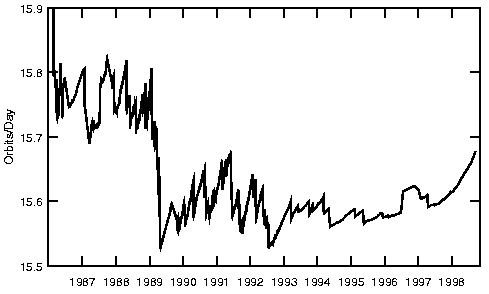
Atmospheric drag causes a satellite to gradually drift closer to the
Earth. This causes its orbital rate to increase gradually, so one
sees the paradoxical effect that drag causes the satellite
to go faster! To keep a space station in orbit for years, one has to
compensate for the drag using a rocket engine or thruster on the space
station. The graph below shows the orbital rate of MIR over a dozen
years.

Clearly changes in orbital rate as large as 0.05 orbits per day are common. In a week this change accumulates into a prediction error of one third of an orbit, or one half hour. Since the thrusting usually raises the orbit, which slows the orbital rate, the space station is occasionally quite far behind the prediction, but this usually only happens once or twice per year. Thus the MIR or ZARYA predictions two weeks ahead should not be used for definitive planning. HST is in a much higher orbit which gives much less atmospheric drag, and does not have any thrusters. Thus the HST predictions should be quite reliable.
© 1998 Edward L. Wright. Last modified 15-Dec-1998